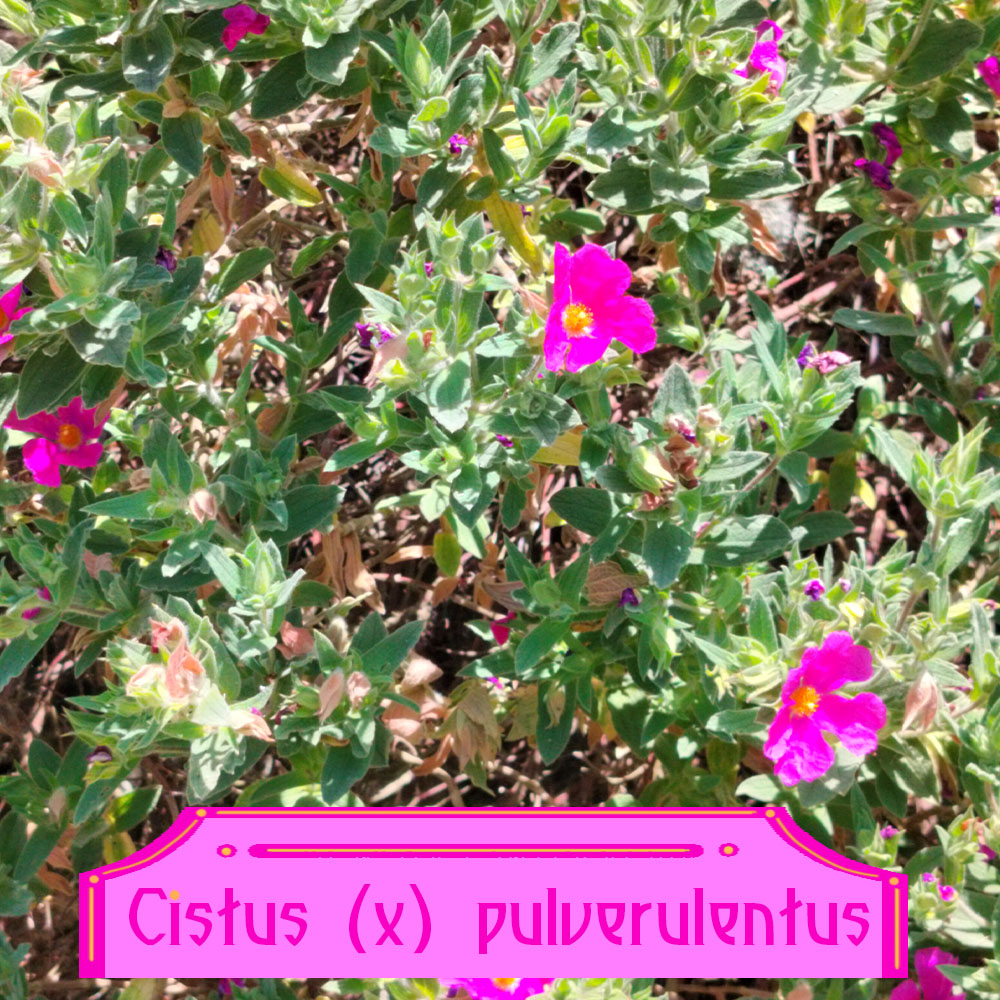-
 € 4,90 × 1×€4.9
€ 4,90 × 1×€4.9
Customer matched zone "Locations not covered by your other zones"
“Cistus x pulverulentus” has been added to your cart. View cart
Cistus x pulverulentus
Dark green velvety bush covered in bright pink flowers
Rated 0 out of 5
0 customer reviews
€ 4,90
Only 31 item(s) left in stock!
Tags: aromatique, bouquets, couleur, evergreen, feuillage persistant, graphique, Jardin Méditerranéen, longue floraison, Mediterranean, pepiniere lhoumois, secheresse, soleil, vivace, vivace en pot, xeriscaping
SKU: pda475
Category: Balcony-Friendly, Bees and Butterflies, Bouquet, Distillations, Evergreen, Fragrant, Frost Hardy, Ground Cover, Medicinal, Rewild, The Stunners

Cistus x pulverulentus
€ 4,90
Only 31 item(s) left in stock!
Cistus × pulverulentus is a vigorous Mediterranean evergreen shrub with a sprawling habit, making it an excellent groundcover for poor, dry slopes.
It features a spectacular flowering period lasting over two months throughout the summer.
Very drought-tolerant, this rockrose is hardy down to about -10 to -12 °C, provided it is planted in well-drained soil and full sun.
The leaves are thick, dark green, puckered, and velvety to the touch. This variety is particular as the leaves are covered with a velvety layer of grey.
The flowers are large and bright pink, highlighted by bright gold stamens.
The root system is both deep and branched. It is so powerful that it can penetrate fractured rocks to extract even the slightest trace of moisture deep underground – making it one of the most drought tolerant plants of the Mediterranean region.
Highly fragrant, the blooms attract butterflies.
Though each flower lasts only a day, their abundance and continuous renewal create a spectacular floral display for several weeks.
👨🌾GARDENING TIP👨🌾:
-
- ✂️ Cistus can be lightly pruned after flowering and pinched back to promote a bushy growth, but avoid cutting into old wood.
- 🪰 Their thick leaves + resin do not attract pests, though their delicate flowers can be damaged by heavy rain
- 🏠 Avoid transplanting them once they are settled, as their roots do not like to be disturbed.
🌱🌿pdA Garden Buddy Suggestions🌱🌿 :
-
- Stachys byzantina, Creeping Thyme, Delosperma, Santolina, Sedum, Lavender, Rosemary, Sages, Tanacetum, Helichrysum
The Tales:
This hybrid resulted from the cross between Cistus albidus (a variety that is highly tolerant of calcareous soils) and Cistus crispus (a low-growing species).
The genus Cistus was named by French botanist Joseph Pitton de Tournefort, derived from the Greek Kistos, which was later Latinized as Cisthos by Pliny the Elder. The genus includes around twenty Mediterranean shrub species in the Cistaceae family, closely related to Halimium and Helianthemum.
These plants have opposite, evergreen to semi-evergreen leaves that are oval to lanceolate, sometimes elongated. Some species, like Cistus ladanifer, contain aromatic resin used to produce medicinal labdanum.
Labdanum is a sticky brown resin extracted from the Cistus plants that is still used to produce perfume and vermouth. You’ll see when you touch the plant, it’s quite sticky.
🔥 Their fruits are fire-resistant capsules, allowing them to reseed naturally after a wildfire.
🥷 They also suppress weed growth through allelopathy (releasing substances that inhibit weed germination) something that our friends in the Thyme family are infamous for.
Other Names:
Rockrose
Origin:
Mediterranean
Similaire
| Weight | 0,2 kg |
|---|---|
| Flower Color | Pink |
| Flowering | June, July, August |
| Exposure | Full Sun |
| Frost Tolerance | -10°C to -15°C |
| Soil | Dry, Poor, Sandy, Well-Draining |
| Size | 0,5m H x 2m W |
| Planting Season | March to May, September to November |
Reviews
0
Rated 0 out of 5
0 customer reviews
5
0
4
0
3
0
2
0
1
0
Only logged in customers who have purchased this product may leave a review.
You may also like…
Cistus monspeliensis
A bush with very fragrant, lanceolate leaves that smell of summer
A bush with very fragrant, lanceolate leaves that smell of summer
Rated 0 out of 5
Lavandula stoechas
A highly aromatic, velvet-leaved, drought resistant, flowering perennial.
A highly aromatic, velvet-leaved, drought resistant, flowering perennial.
Rated 0 out of 5
Santolina chamaecyparissus
A fragrant, evergreyshrub with little yellow button flowers in summer
A fragrant, evergreyshrub with little yellow button flowers in summer
Rated 0 out of 5
Thymus ‘Duftkissen’
Thymus ‘Duftkissen’ is an intensely fragrant and profusely flowering thyme with grey-green, soft leaves.
Thymus ‘Duftkissen’ is an intensely fragrant and profusely flowering thyme with grey-green, soft leaves.
Rated 0 out of 5
Cistus x nigricans
A bush with dark green fragrant leaves that smell of summer
A bush with dark green fragrant leaves that smell of summer
Rated 0 out of 5
Related Products
Echinacea purpurea
A perennial with purple flowers all summer long
A perennial with purple flowers all summer long
Rated 0 out of 5
Stachys byzantina
Silky white-grey leaves and tall striking flowers
Silky white-grey leaves and tall striking flowers
Rated 0 out of 5
Mentha x piperita ‘Chartreuse’
A spicy mint, known for its use in the production of liqueurs and herbal teas.
A spicy mint, known for its use in the production of liqueurs and herbal teas.
Rated 0 out of 5
Glechoma hederacea
A sweet smelling ground cover, producing little blue flowers all summer long.
A sweet smelling ground cover, producing little blue flowers all summer long.
Rated 0 out of 5
Erigeron kavinskianus
A daisy-like carpet of flowers
A daisy-like carpet of flowers
Rated 0 out of 5
Cerastium tomentosum var. columnae
A grey-green spreading ground cover from the mountains.
A grey-green spreading ground cover from the mountains.
Rated 0 out of 5
Kalanchoe daigremontiana
A toothy succulent from Madagascar, known as the Mother of Thousands.
A toothy succulent from Madagascar, known as the Mother of Thousands.
Rated 0 out of 5
Hellebore argutifolius
Winter flowering perennial with marbled blue-green leaves
Winter flowering perennial with marbled blue-green leaves
Rated 0 out of 5
Delosperma cooperi
A dwarf perennial known for its vermillion colored flowers
A dwarf perennial known for its vermillion colored flowers
Rated 0 out of 5
Vinca minor
Looping elegance and ability to form a low flowering ground cover
Looping elegance and ability to form a low flowering ground cover
Rated 0 out of 5
Tanacetum densum subsp. amani
A shrublet composed of soft, finely divided silvery gray-white leaves.
A shrublet composed of soft, finely divided silvery gray-white leaves.
Rated 0 out of 5
Melissa officinalis
A perennial plant in the mint family that is adored by bees, royal families and tea drinkers.
A perennial plant in the mint family that is adored by bees, royal families and tea drinkers.
Rated 0 out of 5
Euphorbia cyparissias Clarice Howard
A Euphorbia that resembles a soft little cyprus tree
A Euphorbia that resembles a soft little cyprus tree
Rated 0 out of 5
Sedum album
A low, multi-color ground cover.
A low, multi-color ground cover.
Rated 0 out of 5
Artemisia ludoviciana ‘Valerie Finnis’
A semi-evergreen, aromatic variation on the theme of Artemisia.
A semi-evergreen, aromatic variation on the theme of Artemisia.
Rated 0 out of 5
Hieracium maculatum ‘Leopard’
A native perennial with blue-green leaves and a tall yellow flower
A native perennial with blue-green leaves and a tall yellow flower
Rated 0 out of 5
Tradescantia andersoniana ‘Blushing Bride’
A Tradescantia with gorgeous blushes of pink and white that appear in the coldest nights.
A Tradescantia with gorgeous blushes of pink and white that appear in the coldest nights.
Rated 0 out of 5
Euphorbia myrsinites
Known for its draping form of silver-gray foliage and radiant blooms.
Known for its draping form of silver-gray foliage and radiant blooms.
Rated 0 out of 5
recent view product
Vinca major ‘Variegata’
Vinca major Variegata is a trailing vine with a magnificent color variegation, spreading along the ground to form dense masses of groundcover, come sun, come shade.
Vinca major Variegata is a trailing vine with a magnificent color variegation, spreading along the ground to form dense masses of groundcover, come sun, come shade.
Rated 0 out of 5
Artemisia ludoviciana ‘Valerie Finnis’
A semi-evergreen, aromatic variation on the theme of Artemisia.
A semi-evergreen, aromatic variation on the theme of Artemisia.
Rated 0 out of 5
Glechoma hederacea
A sweet smelling ground cover, producing little blue flowers all summer long.
A sweet smelling ground cover, producing little blue flowers all summer long.
Rated 0 out of 5
Lavandula stoechas
A highly aromatic, velvet-leaved, drought resistant, flowering perennial.
A highly aromatic, velvet-leaved, drought resistant, flowering perennial.
Rated 0 out of 5
Mentha x gracilis ‘Variegata’
A striking mint with striped and flecked golden-yellow leaves that are gingery-minty.
A striking mint with striped and flecked golden-yellow leaves that are gingery-minty.
Rated 0 out of 5





















































There are no reviews yet.